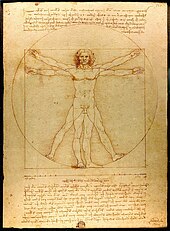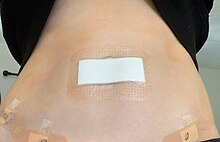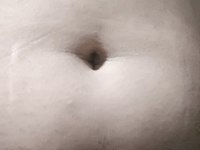Navel
This article about biology may be excessively human-centric. (October 2024) |
| Belly button | |
|---|---|
 A human navel | |
| Details | |
| Precursor | Umbilical cord Ductus venosus |
| Artery | Umbilical artery |
| Vein | Umbilical vein |
| Identifiers | |
| Latin | umbilicus |
| MeSH | D014472 |
| TA98 | A01.2.04.005 |
| TA2 | 261 |
| FMA | 61584 |
| Anatomical terminology | |
The navel (clinically known as the umbilicus; pl.: umbilici or umbilicuses; commonly known as the belly button or tummy button) is a protruding, flat, or hollowed area on the abdomen at the attachment site of the umbilical cord.[1]
Structure
[edit]
The umbilicus is used to visually separate the abdomen into quadrants.[2]
The umbilicus is a prominent scar on the abdomen, with its position being relatively consistent among humans. The skin around the waist at the level of the umbilicus is supplied by the tenth thoracic spinal nerve (T10 dermatome). The umbilicus itself typically lies at a vertical level corresponding to the junction between the L3 and L4 vertebrae,[3] with a normal variation among people between the L3 and L5 vertebrae.[4]
Parts of the adult navel include the "umbilical cord remnant" or "umbilical tip", which is the often protruding scar left by the detachment of the umbilical cord. This is located in the center of the navel, sometimes described as the belly button. Around the cord remnant is the "umbilical collar", formed by the dense fibrous umbilical ring. Surrounding the umbilical collar is the periumbilical skin. Directly behind the navel is a thick fibrous cord formed from the umbilical cord, called the urachus, which originates from the bladder.[5]
The belly button is unique to each individual due to it being a scar, and various general forms have been classified by medical practitioners.[6][7][further explanation needed]
- Outie: A navel consisting of the umbilical tip protruding past the periumbilical skin is an outie. Essentially any navel which is not concave.
- Swirly/spiral: A rare form in which the umbilical cord scar forms a swirl shape.
- Split: The protruding umbilical cord scar extends outwards, but is cleft in two by a fissure which extends part or all the way through the umbilical cord scar. This form is similar in appearance to a coffee bean.
- Protrusion: The umbilical cord remnant is completely divulged, exposing the full umbilical scar.
- Circlet: Although the entirety of the umbilical cord remnant sits out with the umbilical collar, the centre of the knot is inset by a deep fissure. Unlike a split outie, in this form the fissure is contained centrally and does not extend past the umbilical cord remnant in any direction, much akin to a 'donut' shape.[8]
- Innie: A navel in which the umbilical tip does not protrude past the periumbilical skin. Any navel which is concave.
- Round: Round navels are completely circular with no hooding.
- Vertical: Some navels present in the form of a more elongate hollow parallel with the linea alba.
- Oval: This form consists of three variants; superior hooding, inferior hooding, no hooding.
- T-shaped: As the name states, the scar is in the shape of a T, and may have superior hooding to various extent.
- Horizontal: The scar is the least visible, as the natural lines of the tendinous intersection fold over the scar.
- Distorted: Any navel which does not fit well into any of the other categories.
-
A "T"-shaped navel
-
One of many variations of an outie
-
An innie navel
-
An oval navel
-
An outie navel
-
Woman flipping her innie belly button into an outie
-
An innie navel
-
Navel of pregnant woman
Clinical significance
[edit]
Disorders
[edit]Outies are sometimes mistaken for umbilical hernias; however, they are a completely different shape with no health concern, unlike an umbilical hernia. The navel (specifically abdominal wall) would be considered an umbilical hernia if the protrusion were 5 centimeters or more. The diameter of an umbilical hernia is usually 1/2-inch or more.[9] Navels that are concave are nicknamed "innies".[10] While the shape of the human navel may be affected by long term changes to diet and exercise, unexpected change in shape may be the result of ascites.[11]
In addition to change in shape being a possible side effect from ascites and umbilical hernias, the navel can be involved in umbilical sinus or fistula, which in rare cases can lead to menstrual or fecal discharge from the navel. Menstrual discharge from the umbilicus is a rare disorder associated with umbilical endometriosis.[12][13]
Other disorders
[edit]- Omphalitis, an inflammatory condition of the umbilicus in the newborn, usually caused by a bacterial infection.[14][15]
- Omphalophobia is the fear of belly buttons. People suffering from omphalophobia are terrified of belly buttons—their own or, in some cases, those of others. They do not like touching their belly buttons (or even other people touching it). Sometimes just seeing a belly button is enough to make them feel disgusted or terrified.[citation needed]
Surgery
[edit]To minimize scarring, the navel is a recommended site of incision for various surgeries, including transgastric appendicectomy,[16] gall bladder surgery,[17] and the umbilicoplasty[18] procedure itself.
Other animals
[edit]All placental mammals have a navel, although it is generally more conspicuous in humans.[19]
Fashion, society and culture
[edit]The public exposure of the male and female midriff and bare navel was considered taboo at times in the past in Western cultures, being considered immodest or indecent. Female navel exposure was banned in some jurisdictions, but community perceptions have changed to this now being acceptable.[20] The crop top is a shirt that often exposes the belly button and has become more common among young people.[21] Exposure of the male navel has rarely been stigmatised and has become particularly popular in recent years, due to the strong resurgence of the male crop top and male navel piercing.[22] The navel and midriff are often also displayed in bikinis, or when low-rise pants are worn.
While the West was relatively resistant to navel-baring clothing until the 1980s, it has long been a fashion with Indian women,[23] often displayed with saris or lehengas.
The Japanese have long had a special regard for the navel. During the early Jōmon period in northern Japan, three small balls indicating the breasts and navel were pasted onto flat clay objects to represent the female body. The navel was exaggerated in size, informed by the belief that the navel symbolized the center where life began.[24]
In Arabic-Levantine culture, belly dancing is a popular art form that consists of dance movements focused on the torso and navel.[25]
Buddhism and Hinduism refer to the chakra of the navel as the manipura. In qigong, the navel is seen as the main energy centre, or dantian. In Hinduism, the Kundalini energy is sometimes described as being located at the navel.
-
Belly dancers
-
A man wearing a crop top
-
Japanese women performing a traditional Japanese dance Yosakoi in navel-exposing attire in the Yosakoi Matsuri 2006 at Kōchi
-
Jennifer Lopez baring her midriff and belly button while singing in 2012
-
An example of Keely Hodgkinson's track and field uniform which exposes her midriff and belly button while running at the Birmingham Indoor Grand Prix in 2022
-
Katie Swan baring her midriff and outie belly button during a tennis match
-
Sofie Dossi's outie belly button while she prepares to shoot a bow
-
Woman with a pierced belly button
-
Woman wearing a bikini exposing her pierced navel
See also
[edit]References
[edit]- ^ "Definition of NAVEL". Merriam-Webster. 24 November 2023.
- ^ "Anatomy & Physiology". Openstax college at Connexions. 25 April 2013. Retrieved 16 November 2013.
- ^ Ellis, Harold (2006). Clinical Anatomy: Applied Anatomy for Students and Junior Doctors. New York: Wiley. ISBN 1-4051-3804-1.[page needed]
- ^ O'Rahilly, Ronan; Müller, Fabiola; Carpenter, Stanley; Swenson, Rand (2004). "Abdominal walls". Basic Human Anatomy: A Regional Study of Human Structure. Dartmouth Medical School. Archived from the original on 24 July 2012. Retrieved 10 November 2010.
- ^ Khati, Nadia J.; Enquist, Erik G.; Javitt, Marcia C. (1998). "Imaging of the Umbilicus and Periumbilical Region". Radiographics. 18 (2): 413–4. doi:10.1148/radiographics.18.2.9536487. PMID 9536487.
- ^ Shiffman, Melvin (2017). "7.3". Adult Umbilical Reconstruction: Principles and Techniques. Switzerland: Springer. p. 53. ISBN 978-3-319-43885-6.
- ^ Mohamed, Fahmy (2018). "Umbilicus Types and Shapes". Umbilicus and Umbilical Cord. Egypt: Springer. pp. 105–8. doi:10.1007/978-3-319-62383-2_22. ISBN 978-3-319-62382-5.
- ^ Stephen Cullen, Thomas (1916). "2". Umbilicus. Australia: W.B.Saunders Company. p. 1.1–1.7. ISBN 978-0-7334-2609-4.
- ^ Meier, Donald E.; OlaOlorun, David A.; Omodele, Rachael A.; Nkor, Sunday K.; Tarpley, John L. (2001). "Incidence of Umbilical Hernia in African Children: Redefinition of 'Normal' and Reevaluation of Indications for Repair". World Journal of Surgery. 25 (5): 645–8. doi:10.1007/s002680020072. PMID 11369993. S2CID 22628578.
- ^ Ceccanti, Silvia, et al. "Umbilical cord sparing technique for repair of congenital hernia into the cord and small omphalocele." Journal of Pediatric Surgery 52.1 (2017): 192-196.
- ^ Herrine, Steven K. "Ascites". The Merck Manuals.
- ^ Bagade, Pallavi V; Guirguis, Mamdouh M (2009). "Menstruating from the umbilicus as a rare case of primary umbilical endometriosis: a case report". Journal of Medical Case Reports. 3: 9326. doi:10.1186/1752-1947-3-9326. PMC 2803849. PMID 20062755.
- ^ D'Alessandro, Donna M. (2 June 2008). "What's Wrong With His Belly Button?". Pediatric Education.[self-published source?][unreliable medical source?]
- ^ Cunningham, F. Williams Obstetrics: The Newborn (24th ed.). McGraw-Hill.
- ^ Fleisher, Gary R. Textbook of Pediatric Emergency Medicine. Philadelphia: Lippincott Williams & Wilkins, 2006, p. 928.
- ^ Kaehler, G.; Schoenberg, M. B.; Kienle, P.; Post, S.; Magdeburg, R. (2013). "Transgastric appendicectomy". British Journal of Surgery. 100 (7): 911–5. doi:10.1002/bjs.9115. PMID 23575528. S2CID 24285562.
- Sarah Glynn (12 April 2013). "Scarless Surgery Through The Navel Feasible Alternative For Appendicitis". Medical News Today.
- ^ "SRMC Surgeon Offers Gallbladder Removal through Belly Button Incision with da Vinci System" (Press release). Southeastern Health. 9 December 2013. Archived from the original on 4 January 2015. Retrieved 16 August 2015.
- ^ Bruekers, Sven E.; van der Lei, Berend; Tan, Tik L.; Luijendijk, Roland W.; Stevens, Hieronymus P. J. D. (2009). "'Scarless' Umbilicoplasty". Annals of Plastic Surgery. 63 (1): 15–20. doi:10.1097/SAP.0b013e3181877b60. PMID 19546666. S2CID 206034192.
- ^ Mohamed Fahmy (2018). Umbilicus and Umbilical Cord. Springer International Publishing. ISBN 978-3-31962-383-2. Retrieved 7 December 2024.
- ^ "New code may reveal navel". Mohave Daily Miner. 24 March 1985. Retrieved 20 April 2012.
- ^ "Men in crop tops seem to be trending thanks to Kid Cudi, the social media and the catwalk". The Independent. Archived from the original on 18 June 2022. Retrieved 30 January 2019.
- ^ Ktena, Natalie (28 August 2018). "We talked to a 'crop top historian' about the comeback of the male crop top". BBC. Retrieved 14 September 2018.
- ^ Banerjee, Mukulika & Miller, Daniel (2003) The Sari. Oxford; New York: Berg ISBN 1-85973-732-3[page needed]
- ^ Naumann, Nelly (2000). "First Indications of Symbolic Expression". Japanese Prehistory: The Material and Spiritual Culture of the Jōmon Period. Otto Harrassowitz Verlag. pp. 114–5. ISBN 978-3-447-04329-8.
- ^ "Belly Dance History – A History of Belly Dancing « Belly Dance org". bellydance.org. Retrieved 24 December 2018.
Further reading
[edit]- "Belly Button Biodiversity Project". Archived from the original on 30 July 2016. Retrieved 15 April 2020.
- Craig, Stefan B.; Faller, Mary S.; Puckett, Charles L. (2000). "In Search of the Ideal Female Umbilicus". Plastic and Reconstructive Surgery. 105 (1): 389–92. doi:10.1097/00006534-200001000-00062. PMID 10627008.
- Gabriele, Raimondo; Conte, Marco; Egidi, Federico; Borghese, Mario (2005). "Umbilical metastases: current viewpoint". World Journal of Surgical Oncology. 3 (1): 13. doi:10.1186/1477-7819-3-13. PMC 552325. PMID 15723695.
- Moreau, Corrie S.; Hulcr, Jiri; Latimer, Andrew M.; Henley, Jessica B.; Rountree, Nina R.; Fierer, Noah; Lucky, Andrea; Lowman, Margaret D.; Dunn, Robert R. (2012). "A Jungle in There: Bacteria in Belly Buttons are Highly Diverse, but Predictable". PLOS ONE. 7 (11): e47712. Bibcode:2012PLoSO...747712H. doi:10.1371/journal.pone.0047712. PMC 3492386. PMID 23144827.
- Piskun, Gregory; Rajpal, Sanjeev (1999). "Transumbilical Laparoscopic Cholecystectomy Utilizes No Incisions Outside the Umbilicus". Journal of Laparoendoscopic & Advanced Surgical Techniques. 9 (4): 361–4. doi:10.1089/lap.1999.9.361. PMID 10488834.
- "New meaning to 'navel-gazing': Scientists study belly button bacteria". Body Odd. NBC News. 14 April 2011. Archived from the original on 26 July 2016. Retrieved 16 August 2015.
External links
[edit] Media related to Navels at Wikimedia Commons
Media related to Navels at Wikimedia Commons

















